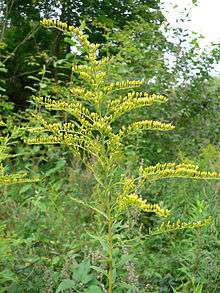Solidago canadensis
| Canada goldenrod | |
|---|---|
 | |
| Scientific classification | |
| Kingdom: | Plantae |
| Clade: | Angiosperms |
| Clade: | Eudicots |
| Clade: | Asterids |
| Order: | Asterales |
| Family: | Asteraceae |
| Genus: | Solidago |
| Species: | S. canadensis |
| Binomial name | |
| Solidago canadensis | |
| Synonyms[1] | |
| |
Solidago canadensis (known as Canada goldenrod[2] or Canadian goldenrod) is an herbaceous perennial plant of the family Asteraceae. It is native to northeastern and north-central North America[3]. It is an invasive plant in other parts of the continent and several areas worldwide, including Europe and Asia.[4][5][6][7] It is often grown as an ornamental in flower gardens.
The plant is erect, often forming colonies. Flowers are small yellow heads held above the foliage on a branching inflorescence.
Ecology and distribution
Solidago canadensis is sometimes browsed by deer and is good to fair as food for domestic livestock such as cattle or horses.[8]
It is found in a variety of habitats, although it is not shade tolerant. It typically is one of the first plants to colonize an area after disturbance (such as fire) and rarely persists once shrubs and trees become established. It is found neither in very dry locations nor in waterlogged ones.[8]
Invasive species
In many parts of Europe, Japan and China, it is established as an invasive weed.
In eastern and southeastern China, particularly the provinces of Zhejiang, Jiangsu, Jiangxi and Shanghai, its invasion has reached pandemic levels and has caused widespread concern. It has been reported that the spread of invasive plants including Canada goldenrod has caused the extinction of 30 native plants in Shanghai.[9] In the city of Ningbo, Zhejiang, it has reduced local orange harvests.[10] It is still spreading across China, and sightings have been reported in as far as Yunnan province. Various national and provincial authorities have been on high alert.
In Fukushima, it has colonized the rice fields that have been temporarily abandoned because of the nuclear power plant disaster.[11]
References
- ↑ "Solidago canadensis". The Global Compositae Checklist (GCC) – via The Plant List.
- ↑ "Solidago canadensis". Natural Resources Conservation Service PLANTS Database. USDA. Retrieved 18 November 2015.
- ↑ "Solidago canadensis". County-level distribution map from the North American Plant Atlas (NAPA). Biota of North America Program (BONAP). 2014.
- ↑ Semple, John C.; Cook, Rachel E. (2006). "Solidago canadensis". In Flora of North America Editorial Committee. Flora of North America North of Mexico (FNA). 20. New York and Oxford – via eFloras.org, Missouri Botanical Garden, St. Louis, MO & Harvard University Herbaria, Cambridge, MA.
- ↑ Altervista Flora Italiana, Verga d'oro del Canadà, Solidago canadensis L. photos, European distribution map
- ↑ Chen, Yilin; Semple, John C. "Solidago canadensis". Flora of China – via eFloras.org, Missouri Botanical Garden, St. Louis, MO & Harvard University Herbaria, Cambridge, MA.
- ↑ Atlas of Living Australia
- 1 2 Coladonato, Milo (1993). "Solidago canadensis". Fire Effects Information System (FEIS). US Department of Agriculture (USDA), Forest Service (USFS), Rocky Mountain Research Station, Fire Sciences Laboratory. Retrieved 2009-08-24 – via https://www.feis-crs.org/feis/.
- ↑ Jiangsu's battle with Canada Goldenrod (Chinese) Archived 2006-06-24 at the Wayback Machine.
- ↑ Jiaodianfangtan (Chinese) Archived 2004-12-17 at the Wayback Machine.
- ↑ Blanchan, Neltje (2005). Wild Flowers Worth Knowing. Project Gutenberg Literary Archive Foundation.
External links
| Wikiversity has bloom time data for Solidago canadensis on the Bloom Clock |


- Jepson Manual Treatment: Solidago canadensis
- United States Geological Survey: Solidago canadensis
- Profile: Canada Goldenrod (Solidago canadensis) Photos, Drawings, Text. (Wild Plants of Winnipeg from Nature Manitoba)
- China Archives, Exotic Plant Spreads Across a Third of Mainland